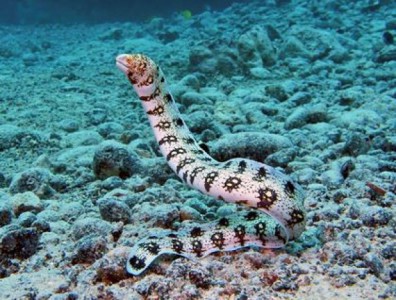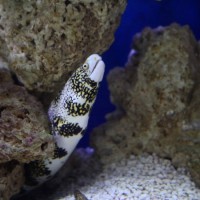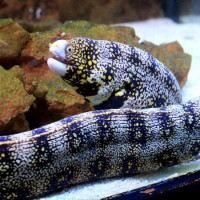- Name:
Snowflake Eel
(View AKA's) - Family: Muraenidae
- Species: Eel
- Scientific Name: Echidna nebulosa




General info about Snowflake Eel
This is a very hardy eel, but an escape artist. A 50 gallon or larger aquarium with plenty of live rock and a tight fit canopy is ideal. Most of the eels that are lost in an aquarium are due to poorly sealed tanks. It can be housed with some invertebrates, like anemones, corals, starfish, sea urchins. Also, other relatively large, aggressive fish, such as lionfish, tangs, triggerfish, wrasses is suitable as tankmates. To put same species into the same tanks is possible only if they introduced to the tank at the same time and also there should be enough rooms and shelter for them to hide. Smaller fish are likely to be eaten by the eel.
They can grow quickly in a rather short period of time, so it is reasonable to get large tanks in the first place. A 50 gallon or larger aquarium is necessary for snowflake eels to live. Since they like to hide in rocks, providing plenty of rock in the tanks will help them adjust to your aquarium they also enjoy caves.
Snowflake Eel Diet & Nutrition
Carnivorous. The main foods in the sea are crustaceans like krill, shrimp and they also have fish that fit in their mouths. Crabs and lobster are also their natural diet. In the wild Snowflake Eel is a nocturnal predator, ambushing fish and crustaceans. In the tank, it will take frozen or freeze-dried krill, fish, shrimp, and most meaty foods enriched with vitamins. It can be taught to be feed by hand, although this could be done with caution it is not recommended how they can inflict a painful bite and poor eyesight. Long tweezers or tongs can be used to feed them.
Unless already acclimated to frozen foods, the moray eel will likely need to be fed with live ghost shrimp when first acquired. Avoid feeding them goldfish or rosy reds because this is known to cause liver disease.
Determining Sex of Snowflake Eel
Snowflake eel could be androgynous. Also there is no distinguishable difference between sexes. In the same environment, more dominant eel will change from female to male, meaning that they are protogynous also. However, this process can take a long time.
Breeding & Spawning Snowflake Eel
Snowflake eels are egg scatterers that produce eggs often in midwater mating rituals. Their eggs and larvae drift with plankton in the water column and settle back onto a reef at about the time of hatching. That's why spawning is very hard in captivity for snowflake eels.
Snowflake eels are protogynous, meaning the more dominant eel will change from female to male. Again this brings more issues, as eels are generally peaceful toward one another. Gender changing can take several months to years, which is far longer than most breeders are willing to wait.
Common Diseases with Snowflake Eel
Snowflake eel is actually good at adapting to aquarium condition and kind of resistant to diseases.
Snowflake Eel Origin
Indian Pacific: From the Red Sea and East Africa to the Society Islands; south of Japan and the Hawaiian Islands in the north, Lord Howe Island in the south; Throughout Micronesia.
Eastern Pacific: Southern of Lower California, Mexico and Costa Rica to the north of Colombia.
It is also found in the Southeast Atlantic.
Caution with Snowflake Eel
Since they are good at escaping, it is important to seal the tanks well.
Snowflake morays are reef safe and will not bother corals, though these eels are messy eaters and will require strong filtration and a relatively large protein skimmer for the long-term health of any corals housed in their aquarium.
Acclimating Snowflake Eel
Original Detail
| Name | Species | Family | Scientific Name | More Detail | Added by |
|---|---|---|---|---|---|
| Snowflake Eel | Eel | Muraenidae | Echidna nebulosa | This is a very hardy eel, but an escape artist. A 50 gallon or larger aquarium with plenty of live rock and a tight fit canopy is ideal. Most of the eels that are lost in an aquarium are due to poorly sealed tanks. It can be housed with some invertebrates, like anemones, corals, starfish, sea urchins. Also, other relatively large, aggressive fish, such as lionfish, tangs, triggerfish, wrasses is suitable as tankmates. To put same species into the same tanks is possible only if they introduced to the tank at the same time and also there should be enough rooms and shelter for them to hide. Smaller fish are likely to be eaten by the eel. They can grow quickly in a rather short period of time, so it is reasonable to get large tanks in the first place. A 50 gallon or larger aquarium is necessary for snowflake eels to live. Since they like to hide in rocks, providing plenty of rock in the tanks will help them adjust to your aquarium they also enjoy caves.
|
PalaciosAn |
Changed by users
| Submitted Date | Submitted By | Status | Action |
|---|



